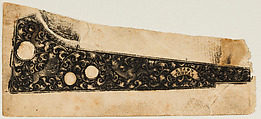Ink Impression ("Pull") from a Gold-inlaid Colt Revolver
Decorator Gustave Young American, born Prussia
Not on view
This pull was taken from the frame of an engraved, gold-inlaid Colt revolver as a record of its decoration. The pistol, which is not known to survive, belonged a rarefied group of Colt percussion firearms embellished with profuse engraving, relief carving, and flush or low relief gold inlay, of which about twenty examples are known. Three are preserved in The Met’s collection (acc. nos. 1995.336; 2018.856.1; 2018.856.2a–o; also see acc. no. 2014.699). Made at Samuel Colt’s (1814–62) direction for exhibition at international fairs and for presentation to important officials and foreign and domestic heads of state, including the kings of Sweden and Denmark and the Czar of Russia, they functioned as diplomatic gifts and demonstrations of the company’s artistic and technical achievements.
The pull may be attributed to the famous German-American firearms engraver Gustave Young (see acc. no. 2002.233.2–.26; 2003.521; 2009.330; 2010.481a–l). Young immigrated to the United States in 1852 and became a naturalized citizen in 1858, engraving for Colt from 1853–58 and rising to become Colt’s primary engraving contractor from 1855–58. After a hiatus in Germany he rejoined Colt in the early 1860s. Young also engraved for the New Haven Arms Company, Smith & Wesson, as well as other arms makers.
The Museum’s pull, and indeed all of Young’s engraved scrollwork designs, reflects the artist’s German roots. Young trained under the master Ernst Moritz in Zella, Thuringia, Germany, and a pull in the Museum’s collection depicting a stumbling hunter amidst scrollwork previously attributed to Young but in fact singed discretely by Moritz testifies to the similarity of their styles (acc. no. 2002.233.25). Young’s inspiration for the gold-inlaid Colt frame design may be traced specifically to Plate 3 of a pattern book by the Zella engraver Gustav Ernst, Musterblätter enthaltend die anwendbarsten Jagdstücke u. Arabesken für Büchsenschäfter, Graveure etc., published in 1850 (acc. no. 2002.233.1a–j). Ernst was an instructor at the Industrial School in Zella and he is believed to have trained many of the most talented German firearms engravers who would go on to settle in America and decorate for Colt, Winchester, Smith & Wesson, and other major arms manufacturers, among them Louis D. Nimschke (1832–1904) (see acc. nos. 2018.856.19; 2018.856.20a–jjj), Herman Bodenstein (1829–65), and John Marr (1831 – 1921). Ernst’s six influential pattern books, published between 1839–1853, perhaps more than any other printed source informed the style of these engravers throughout their careers.
Due to rights restrictions, this image cannot be enlarged, viewed at full screen, or downloaded.

